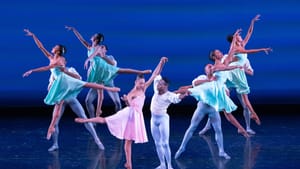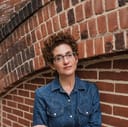Stay in the Loop
BSR publishes on a weekly schedule, with an email newsletter every Wednesday and Thursday morning. There’s no paywall, and subscribing is always free.
Dance to take you higher
Dance Theatre of Harlem presents premieres by William Forsythe and Robert Garland

Dance Theatre of Harlem (DTH) returned to Penn Live Arts with four works that demonstrated the company’s versatility and range. Co-founded by Arthur Mitchell, who became the first African American principal dancer in a major ballet company during his tenure at New York City Ballet, and Dutch ballet master Karel Shook, DTH was the first Black classical ballet company. For more than half a century, DTH has expanded viewers’ ideas of what ballet is and what it can be.
Balanchine beginnings
Fittingly, the program began with a classical ballet by George Balanchine, who granted Mitchell access to his work in support of DTH. Allegro Brillante (1956) reflects the joy and power of dance. Though relatively short, it packs a punch through its lively pace and choreographic variety. Derek Brockington, Micah Bullard, Lucas Castro, Kouadio Davis, Lindsey Donnell, Yinet Fernandez, Daphne Lee, and Kamala Saara moved in a pinwheel formation to the lively opening movement of Tchaikovsky’s Piano Concerto No. 3. Ingrid Silva and Christopher Charles McDaniel dazzled as the lead couple.
Silva brought both grace and technical mastery to the elegant yet demanding choreography, while McDaniel completed a perfect lift by setting her down weightlessly onto the tips of her pointe shoes. Costumes by Katy A. Freeman captured the aesthetic of classical ballet, and lighting recreated by Andrea Sala highlighted the second section’s dramatic poses. Some of the male dancers’ turns seemed a little off, striking the only dissonant note.
Lee and Davis danced the duet When Love (2012) by Helen Pickett, an abstract and sensual exploration of the interplay between romantic love and time. The work began with the dancers’ backs to the audience, suggesting their absorption in one another. Lee’s deep backbends, precise turns, and expressive face portrayed a consuming love. Davis partnered her expertly, lending graceful strength to a series of complex contact sequences including spinning low lifts.
Higher Ground
Higher Ground (2022) represents DTH resident choreographer and Philadelphia native Robert Garland’s “Sankofa-esque reflection on our current times.” Invoking the Ghanaian principle of valuing the wisdom of the past, Higher Ground refracts contemporary themes through lyrical, social, and hip-hop dance as well as the music of Stevie Wonder. Interestingly, Higher Ground drew from the legendary musician’s deeper cuts rather than his best-known hits. This worked particularly well in sequences set to “Village Ghetto Land” and “Saturn” (both 1976), which formed a dyad that juxtaposed cruel realities with Afrofuturistic, utopian visions.
In “Village Ghetto Land,” Donnell portrayed a struggling character met with indifference and rejection from others. Brockington, Castro, Silva, and David Wright depicted people so engrossed with their cell phones that they don’t notice someone right in front of them. Finally seeing Donnell, they use their phones to mock her. But “Saturn” followed this, pairing Wonder’s lyrics about a reachable place free of this world’s problems with sweeping movement, joyful pairings, and kinetic lifts.
Higher Ground’s opening sections and its final segment, set to the song of the same name (1973), incorporated elements of hip-hop dance, such as body rolls and booty pops. Altogether, Higher Ground made unforced and meaningful connections between the past and present. Garland’s incorporation of various styles of dance and movement and his use of music from Stevie Wonder’s classic period to explore contemporary subjects made me interested to see more from this choreographer.
Past, present, and future of contemporary ballet
The final piece was the world premiere of the latest installment of William Forsythe’s The Barre Project. Inspired by dancers whose creativity and commitment sustained their art and conditioning during the pandemic, the series began in 2021 with dance films streamed to global audiences unable to see live performances. The new installment, Blake Works IV, continues a relationship between Forsythe’s choreography and the moody, experimental electronic music of James Blake. Dancers moved by themselves and in pairs across a space with a makeshift ballet barre. The barre made a terrific prop that dancers moved across and used as leverage in varied and creative ways.

Blake’s songs ranged from haunting to ominous to industrial to ballad-like, with largely unintelligible lyrics. Forsythe’s choreography and Brandon Stirling Baker’s light design matched them with mesmerizing visual effects. Brockington, Bullard, Castro, Davis, Donnell, Fernandez, Lee, McDaniel, Sanford Placide, Saara, Dylan Santos, Amanda Smith, Delaney Washington, and Wright seemed to keep the music’s tempo with their bodies. They even seemed to pass it between their bodies like an invisible relay baton. When the dancers joined together for a synchronous section, I sensed Blake Works IV drawing to a close. However, the end still felt abrupt and a bit unsatisfying considering this otherwise strong installment of a fascinating project.
Unfolding in chronological order, the program took viewers on a journey through DTH’s past into its present, with a view to the future for the company as well as contemporary ballet. From a classical ballet from the mid-20th century to a new work growing out of the pandemic’s virtual performances and rehearsals, dancers shone in entertaining works full of technical skill, athleticism, grace, and expressiveness.
What, When, Where
Penn Live Arts presents Dance Theatre of Harlem. Choreography by Robert Garland, George Balanchine, William Forsythe, and Helen Pickett. $29-$89. January 20-21, 2023, at the Zellerbach Theater of Penn Live Arts, 3680 Walnut Street, Philadelphia. (215) 898-3900 or pennlivearts.org.
Accessibility
Masks were encouraged, but not required.
Penn Live Arts offers wheelchair-accessible seating, free admission for personal care attendants, large-print programs, and assistive listening devices. Visit the venue’s accessibility page for more info.
Sign up for our newsletter
All of the week's new articles, all in one place. Sign up for the free weekly BSR newsletters, and don't miss a conversation.

 Melissa Strong
Melissa Strong